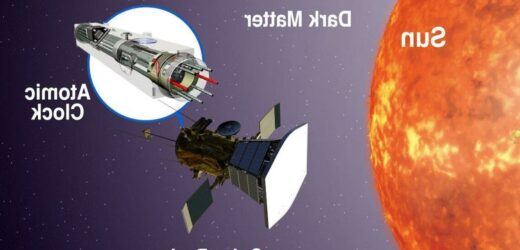Atomic clocks: Science expert explains how they work
We use your sign-up to provide content in ways you’ve consented to and to improve our understanding of you. This may include adverts from us and 3rd parties based on our understanding. You can unsubscribe at any time. More info
Physicists could finally solve the mystery of dark matter by analysing atomic clocks placed onboard a spacecraft in orbit inside of Mercury’s orbit, close to the Sun. This is the suggestion of a study by cosmologist Dr Joshua Eby of the University of Tokyo and his colleagues Dr Yu-Dai Tsai of the University of California, Irvine and Professor Marianna Safronova of the University of Delaware. Our theoretical understanding of the distribution of dark matter in the Solar System is presently constrained entirely by data on the orbit of the planets. In the area of space inside of Mercury’s orbit, however, there is almost no constraint — and so taking a measurement here, the team explained, could place pioneering limits on the concentration of dark matter used in theoretical models.
“Dark matter” is the name that physicists have given to the mysterious component of the universe whose existence — and gravitational influence — is needed to fully explain the motion of stars within galaxies.
It is estimated that around 27 percent of the universe’s total mass and energy may be composed of dark matter — and as much as 85 percent of its mass alone.
Despite this, however, dark matter has never been directly detected. Scientists believe, however, that dark matter particles with very small masses may be capable of inducing oscillations in the very constants of nature.
Specifically, it is thought that so-called ultralight dark matter can change the mass of the electron and the interaction strength of the electromagnetic force. The result of this is that the dark matter should slightly change the transitions involved between various states in both atoms and nuclei.

This is where atomic clocks come in. These advanced timepieces keep on track by carefully measuring the excitation of atoms. The impetus for this is driven by bombarding the atoms with photons produced by the resonance of a quartz crystal — much like the ones found in the clocks you may have at home.
Quartz crystals are fine for conventional timepieces, but the rate at which they vibrate can be affected by environmental conditions — losing up to a billionth of a second every hour. Atomic clocks self-correct by using a quartz crystal tuned to the exact frequency needed to create microwaves that can excite a particular atomic element.
These microwaves are fired at the atoms, and a magnetic detector checks that enough of the atoms are indeed excited into a higher energy state. If this is not achieved, the system knows to stimulate the quartz oscillator to get its vibrations back on track.
With the oscillator kept at the correct frequency, then, one can count each vibration of the crystal to mark the passing of time, much in the same way that classical clocks employ a measurement of the oscillations of a pendulum.
However, atomic clocks remain sensitive to ultralight dark matter. As the researchers explain: “The oscillations of the ultralight dark matter field can induce a time-varying contribution to fundamental constants, including the electron mass and fine-structure constant.”
What this means in practice is that the frequency (and, by extension, energy) of the microwave photons needed to excite the titular atoms in an atomic clock changes slightly based on the presence of dark matter.
Dr Eby adds: “The more dark matter there is around the experiment, the larger these oscillations are, so the local density of dark matter matters a lot when analysing the signal.”
By sending up two different atomic clocks that have different sensitivities to the variation of fundamental constants caused by dark matter, it would be possible to take a rough measurement of the dark matter concentration in the area.
DON’T MISS;
Biggest energy saving hacks for boilers as temperatures set to plunge [INSIGHT]
OVO customers handed huge boost with free service to help slash £260 [REPORT]
Smart meter customers suffer ‘nightmare’ over issues with devices [ANALYSIS]
The tech to put this concept into practice already exists, the team notes, with NASA’s Sun-analysing Parker Space Probe already operating inside the orbit of Mercury.
Dr Eby said: “A possible future mission, with shielding and trajectory very similar to the Parker Solar Probe, but carrying an atomic clock apparatus, could be sufficient to carry out the search.”
Hunting for dark matter is not the only reason why you might want to place a quantum clock on board a spacecraft, the researchers noted.
Dr Eby explained: “Long-distance space missions, including possible future missions to Mars, will require exceptional timekeeping as would be provided by atomic clocks in space.
The full findings of the study were published in the journal Nature Astronomy.
Source: Read Full Article


